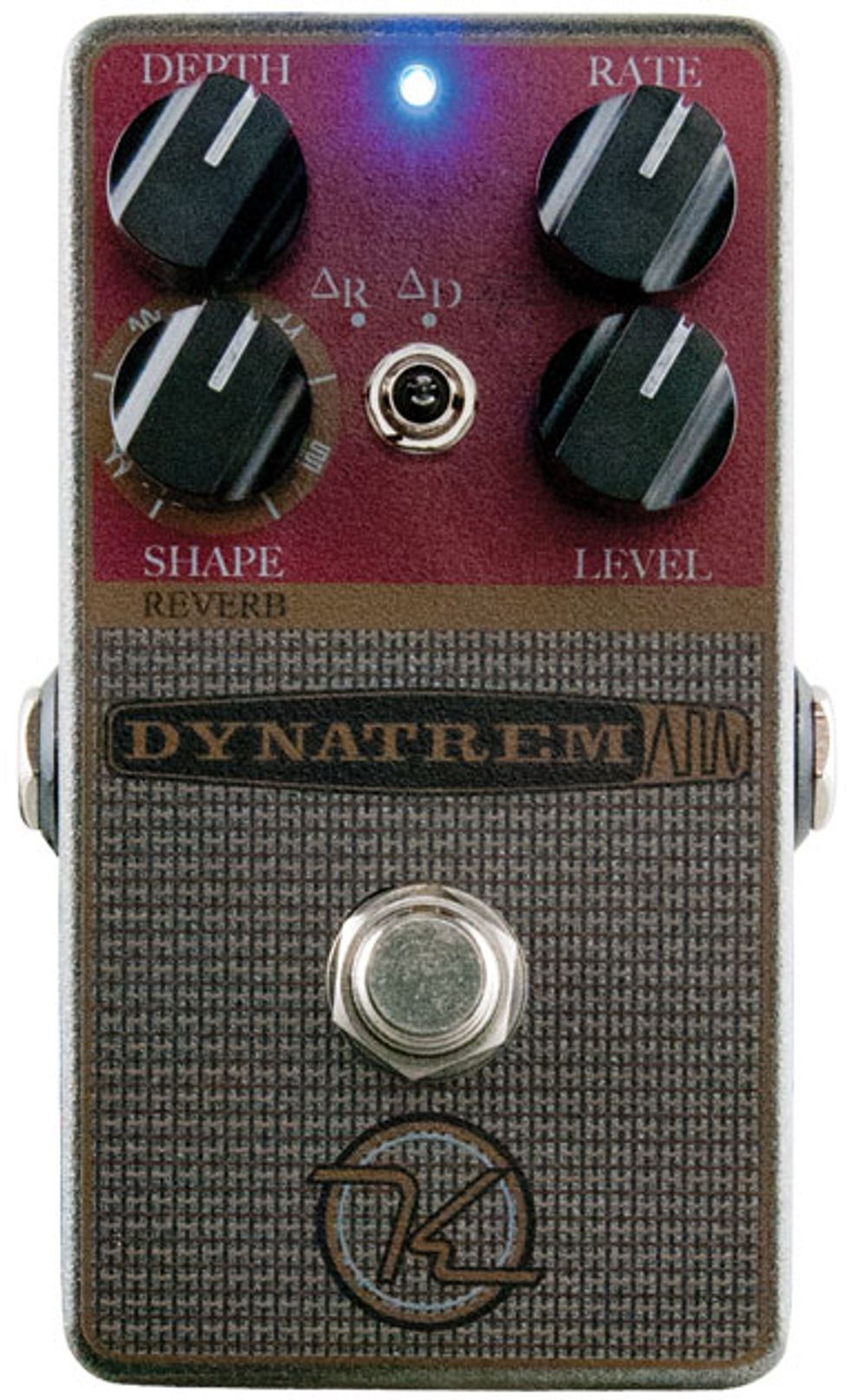For a couple of decades now Robert Keeley’s name has largely been synonymous with his great-sounding takes on the rare old Ross Compressor pedal, but in the last year Keeley has worked hard to change that: He’s modified and downsized many previous designs, explored more eye-grabbing visuals, and released around 20 new pedals—many of which prove that he’s as interested as newer pedal outfits in exploring unusual sounds. The DynaTrem is a perfect example of the latter. While its name and amp-grille graphics might convey a stomp aiming for classic-voiced, amp-style tremolo, the DynaTrem has loftier, weirder goals.
Delta, Delta, Sum
The “Dyna” part of the new Keeley’s moniker isn’t just some ’70s-style way of saying “It sounds groovy, man.” It’s telling you that the effect responds to input dynamics by mapping either rate or depth to the volume of your playing. The DynaTrem serves up this dynamic responsiveness in two modes (selectable via a 3-way toggle) and via four knobs: depth, rate, shape/reverb, and level. The way this is communicated on the pedal’s face may conjure fond memories/nightmares/cold sweats from past geometry, trigonometry, and/or calculus courses, depending on your tolerance for such horrors: All three mode labels use a Greek character—either Δ (Delta) or Σ (Sigma)—in an effort to succinctly communicate the chosen function’s basic gist. Δ (which means “4” in math, according to Prof. Wikipedia) seems to refer to the four waveforms you can select using the shape knob in ΔD and ΔR modes. I’m no engineer, but I presume ΣNT mode’s “Σ” character (which means “sum”) refers to how this mode sums rate and depth values, and/or the fact that here there’s an added reverb effect. (In this mode, shape/reverb governs reverb level rather than selecting waveform.)
In ΔR mode, a louder signal increases the speed of the on/off volume vacillation, while ΔD mode gives you a deeper, more dramatic sound as the intensity of your signal increases. Selecting ΣNT engages a “harmonic tremolo and reverb” function. This is the DynaTrem’s only mode that doesn’t track dynamics, and it aims for the unique sound of old Magnatone amp tremolo circuits, which modulated pitch to create a vibrato-like tremolo effect rather than true, volume-modulated tremolo.
All About Dynamics
Despite all the Greek symbols, getting cool sounds from the DynaTrem has nothing to do with mathematical ability and a lot to do with the art of evincing subtle tonal shades by mere attack variance. The more adept you are at exploring gradations between whisper quiet, moderate volume, and ham-fisted glory, the more fun you’ll have with the ΔR and ΔD settings.
Ratings
Pros:
Fascinating sound possibilities. Wonderful Magnatone-esque flavors. Level knob makes trippy settings audible in a mix.
Cons:
No standard trem mode. Stark volume contrasts can garble dynamic rate or depth changes. Lackluster reverb.
Tones:
Ease of Use:
Build/Design:
Value:
Street:
$199
Robert Keeley Electronics
robertkeeley.com
In many ways, the sonic results are as wonderfully simple as the DynaTrem’s premise suggests: In ΔR mode and with my Teles and Jazzmaster-ish Eastwood baritone running into tube amps on the verge of breakup, I could go from a subtle lilting sound when I gently brushed the strings with my fingertips to increasingly undulating swells the harder I dug in with a pick. With a careful increase in playing intensity, it can be quite exhilarating—a bit like how a Leslie’s rotary speaker can be set to gradually increase to top speed. And when you hit a chord hard and let it sustain, you can get hypnotic, quasi synth-y sounds that seem to get zapped by a debilitating slow-mo’ gun as they blast out to space.
Toggle to ΔD, and the depth knob sets how extreme your volume cut will be at full attack. Here, you can go from clear, quiet, nearly un-effected passages to beautifully cozy oscillations or disorienting, hyper-chopped sounds, depending on the selected waveform.
For a lot of players, ΣNT mode will be the DynaTrem’s main attraction: It doesn’t require paying careful attention to playing dynamics, and it avails a nice approximation of the Maggie-trem flavor—gritty and hypnotic, with anything from mildly trippy to nauseatingly psychotic on tap.
The VerdictThe reasonably sized DynaTrem does things few current trem pedals can. The unit we got (serial no. 0084) didn’t let you bypass input-volume tracking when you’re not in the mood for Maggie, but DynaTrems with a serial no. greater than 0300 now avail traditional, non-dynamic triangle-wave trem sounds when shape/reverb is at minimum in ΔD and ΔR modes. Even if that weren’t the case, the Keeley’s Magnatone flavors alone are pretty damn compelling, and the two dynamics-tracking modes offer intriguing sonic possibilities you’d be hard-pressed to find anywhere else.








![Rig Rundown: Russian Circles’ Mike Sullivan [2025]](https://www.premierguitar.com/media-library/youtube.jpg?id=62303631&width=1245&height=700&quality=70&coordinates=0%2C0%2C0%2C0)

















